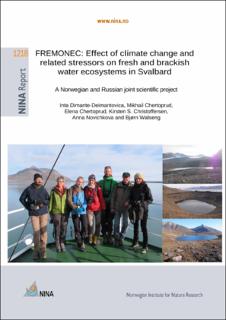| dc.contributor.author | Dimante-Deimantovica, Inta | |
| dc.contributor.author | Chertoprud, Mikhail | |
| dc.contributor.author | Chertoprud, Elena | |
| dc.contributor.author | Christoffersen, Kirsten S. | |
| dc.contributor.author | Novichkova, Anna | |
| dc.contributor.author | Walseng, Bjørn | |
| dc.date.accessioned | 2016-02-25T13:58:45Z | |
| dc.date.available | 2016-02-25T13:58:45Z | |
| dc.date.issued | 2016-02-25 | |
| dc.identifier.isbn | 978-82-426-2848-0 | |
| dc.identifier.issn | 1504-3312 | |
| dc.identifier.uri | http://hdl.handle.net/11250/2380592 | |
| dc.description.abstract | Dimante-Deimantovica, I., Chertoprud, M., Chertoprud, E., Christoffersen, K.S., Novichkova, A. & Walseng, B. 2015. FREMONEC: Effect of climate change and related stressors on fresh and brackish water ecosystems in Svalbard. A Norwegian and Russian joint scientific project. - NINA Report 1218. 40 pp.
This report summarizes the results of the Russian-Norwegian collaboration project FREMONEC which was established as part of POLRES (Polar Research sub-program NORRUSS) with the aim to stimulate bilateral cooperation on polar research. Researchers from The Norwegian Insti-tute for Nature Research and M. V. Lomonosov Moscow State University have studied the effects of climate change and related stressors on fresh and brackish water habitats, by using inverte-brates as biological quality elements. Both partners were involved in preparing the study design, as well as participating in meetings, fieldwork (2014 and 2015) and analyzing/reporting of col-lected material. Altogether, 75 localities in Isfjorden and Kongsfjorden areas, including both lotic and lentic waters, were sampled. pH varied between 6.2 and 9.5 and conductivity from < 0,01 to ˃ 10000 μS/cm. In general, biodiversity was low, especially when we compare Svalbard with other areas in the high and low Arctic. Still this survey revealed 6 microcrustacean taxa new to Svalbard: Polyphemus pediculus, Diaptomidae sp., Diacyclops abyssicola, Epactophanes rich-ardi, Nitokra spinipes and Geeopsis incisipes. Most likely, some of these newcomers are directly or indirectly linked to the recent climate warming (obtained results were compared with old liter-ature data). For macrozoobenthos it seemed that the origin of habitat, temperature, substrate type and water velocity were of importance. The number of crustaceans increased with the age of the localities (distance to the retreating glacier). For instance, the youngest habitats close to the glacier had the lowest number of copepod species and no cladocerans. The fauna in ‘urban’ ponds near human settlements did not differ from non-urban habitats. In the urban ponds, birds seem to be a more important factor than anthropogenic activities, contributing to diversity. As part of this project, one bachelor and one PhD student completed their theses. The network building between Norwegian and Russian research groups, which has included thematic areas relevant for both countries, has been a positive experience for both partners. Further, new knowledge on Svalbard’s biodiversity might give a contribution to future Arctic Freshwater Biodi-versity Monitoring activities and to the implementation of integrated and sustainable Arctic fresh-water ecosystems management. Because of FREMONEC, new collaboration projects and dis-semination activities have also been initiated (projects NORUSVA and BRANTA-DULCIS). | nb_NO |
| dc.description.abstract | Denne rapporten oppsummerer det norsk-russiske samarbeidsprosjektet FREMONEC som er en del av POLRES (underprogram NORRUSS), og som tar sikte på utvikle bilateralt samarbeide om forskning I nordområdene. Forskere fra Norsk institutt for naturforskning og M. V. Lomonosov Moscow State University har studert mulige indirekte og direkte effekter av klimaendringer på faunaen i fersk- og brakkvann på Svalbard. Samarbeidet har innbefattet utarbeidelse av studie-design, møtevirksomhet, feltarbeid (2014-2015), analyser og rapportskriving. Tilsammen 75 lo-kaliteter i Isfjorden- og Kongsfjordenområdet, både stillestående og rennende vann, ble prøve-tatt. pH varierte mellom 6,2 og 9,5 mens ledningsevnen var < 0,01- ˃ 10000 μS/cm. Generelt var det lav artsrikhet, særlig når vi sammenligner med andre nordområder. Likevel ble det funnet 6 taksa av småkreps som var nye for Svalbard: Polyphemus pediculus, Diaptomidae sp., Diacy-clops abyssicola, Epactophanes richardi, Nitokra spinipes og Geeopsis incisipes. Enkelte av disse artene har sannsynligvis etablert seg som følge av at klimaet har endret seg, noe som kom fram når resultatene ble sammenlignet med historiske data. For makroinvertebratene var opp-rinnelsen til habitatet, temperatur, type substrat og vannhastighet viktig. Artsantallet til krepsdyr økte med alderen til lokaliteten, i vårt tilfelle vil det si med avstanden til isbreen. De yngste loka-litetene manglet vannlopper og hadde kun en eller noen få arter av hoppekreps. Vannforekoms-ter nær bebyggelse skilte seg ikke ut med hensyn til fauna. Her er sannsynligvis gjødslingsef-fekten fra fugl en viktigere faktor enn menneskelige virksomhet. Både en bachelor- og en PhD-student fullførte sine grader i forbindelse med prosjektet. Samarbeidet har inkludert temaer som har vært relevante for begge partnere, og har vært en svært positiv erfaring. Videre vil ny kunn-skap om Svalbards biodiversitet gi viktige bidrag til framtidig forvaltning og overvåking av fersk-vannsforekomster. I kjølvannet av FREMONEC er det startet opp to nye forskningsrådsprosjek-ter basert på samarbeid mellom de samme forskerne (NORUSVA og BRANTA-DULCIS). | nb_NO |
| dc.language.iso | eng | nb_NO |
| dc.relation.ispartofseries | NINA Rapport;1218 | |
| dc.subject | Svalbard | nb_NO |
| dc.subject | freshwater | nb_NO |
| dc.subject | brackish water | nb_NO |
| dc.subject | zooplankton | nb_NO |
| dc.subject | benthos | nb_NO |
| dc.subject | climate changes | nb_NO |
| dc.subject | glaciers | nb_NO |
| dc.subject | urban fauna | nb_NO |
| dc.subject | NINA Rapport | nb_NO |
| dc.subject | ferskvann | nb_NO |
| dc.subject | brakkvann | nb_NO |
| dc.subject | dyreplankton | nb_NO |
| dc.subject | bunndyr | nb_NO |
| dc.subject | klimaendringer | nb_NO |
| dc.subject | isbreer | nb_NO |
| dc.title | FREMONEC: Effect of climate change and related stressors on fresh and brackish water ecosystems in Svalbard. A Norwegian and Russian joint scientific project | nb_NO |
| dc.type | Research report | nb_NO |
| dc.source.pagenumber | 40 pp. | nb_NO |
| dc.relation.project | The Research Council of Norway: 227024/E10 | nb_NO |
| dc.description.localcode | © Norwegian Institute for Nature Research The publication may be freely cited where the source is acknowledged | nb_NO |
